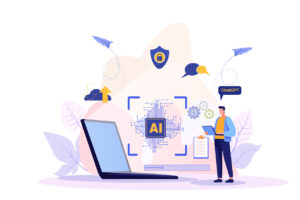AI for communicators: What’s new and what matters
Fresh data around AI training, the Copyright Office’s public comment period, and new workplace tools from Zoom and Google.

It’s hard to believe that generative AI only exploded into the public consciousness with the broad release of ChatGPT this past November. Since then, it’s upended so many aspects of life — and threatens to change many more.
Now, we’re reassessing the role that comms leaders play in providing AI training and support to creatives after Labor Day while thousands are still striking for assurances that AI won’t render their jobs obsolete.
We’re also looking at fresh data about how AI training opportunities are still lacking despite worker demand, new AI-powered tools from Zoom and Google, the current state of AI copyright regulations and more.
Here’s what’s happened just over the past two weeks in the world of AI — brace yourself, it’s a lot.
Most don’t trust the private sector to self-regulate on AI
Fresh data from Axios found that 37% of AI experts at leading universities support the creation of a federal AI department or some similar global regulator. That option beat out trusting a global org or treaty to regulate (22%), Congress (16%) or the White House (4%).
This research was unveiled a week before several AI forums take place on Capitol Hill beginning Sept. 13. Hosted by Senate Majority Leader Chuck Schumer, the discussions will feature top U.S. tech CEOs and AI specialists arguing for its merits. As past discussions with tech leaders on The Hill have shown, whether any headway is made will likely depend on the ability of those holding the forums to articulate a sufficient knowledge of their concerns around AI — and the tech leaders’ ability to offer real, transparent answers that don’t condescend or sow division.
An open public comment period on AI copyright regulations
Last month, a judge ruled that AI-generated art can’t be copyrighted as it involves no human authorship.
“Copyright has never stretched so far […] as to protect works generated by new forms of technology operating absent any guiding human hand, as plaintiff urges here,” Judge Beryl Howell of the US District Court for the District of Columbia wrote in the ruling. “Human authorship is a bedrock requirement of copyright.”
While the ruling affects images specifically, the precedent it sets around human authorship may well impact written work, too. Last week, the U.S. Copyright Office opened a public comment period to hear people’s ideas and concerns about AI as it pertains to ownership. The office said that what it learns will inform its rules and regulations going forward.
According to its notice in the Federal Register:
The United States Copyright Office is undertaking a study of the copyright law and policy issues raised by artificial intelligence (“AI”) systems. To inform the Office’s study and help assess whether legislative or regulatory steps in this area are warranted, the Office seeks comment on these issues, including those involved in the use of copyrighted works to train AI models, the appropriate levels of transparency and disclosure with respect to the use of copyrighted works, and the legal status of AI generated outputs.
This level of transparency and dialogue brings new perspective to a looming question: Who gets a say in how AI affects their lives and their business? Communication can take inspiration from the Copyright Office and open an employee comment period about AI use, thinking through the touchpoints and forum that would be most appropriate based on your work arrangements and org structure.
Whether you form a council of those taking an early-adopter mentality to implementing AI, send out a survey, ask managers to discuss one-on-one, or some combination of the three will depend on the needs of your business. In any case, putting the people your decisions will affect at the forefront will ensure that human authorship remains intact when further regulations solidify — and protect your proprietary content in the process.
Zoom and Google unveil new AI tools for work
Zoom rebranded its existing AI features and introduced new ones. The former Zoom IQ tool, now called the AI Companion, uses the company’s in-house generative AI tool along with AI models from Meta, OpenAI and Anthropic. The biggest change is its scope: The AI Companion will work with Zoom Whiteboard, Zoom Team Chat and Zoom Mail.
The company also teased the release of a ChatGPT-style bot coming next Spring to its AI Companion that will allow users to chat with it directly, asking questions to catch up on key points from meetings and summarize next steps among other things. Zoom also teased the tool’s ability to give users “real-time feedback” on presence in meetings, along with coaching on their communication skills.
The timing of these new features is questionable following recent blowback the company received over its updated terms of service.
The news comes after controversy over changes to Zoom’s terms of service, which implied that Zoom reserved the right to use customers’ videos to train its AI tools and models. In response to the blowback, Zoom updated its policy to explicitly state that “communications-like” customer data won’t be used in training AI apps and services for Zoom or its outside partners.
“Zoom’s goal is to invest in AI-driven innovation that enhances user experience and productivity while prioritizing trust, safety and privacy,” Zoom wrote in a press release shared with TechCrunch. “In August, Zoom shared that it doesn’t use any customer audio, video, chat, screen-sharing, attachments or other communications-like customer content (such as poll results, whiteboards or reactions) to train Zoom’s or third-party AI models.”
Google also introduced a new AI tool last week with the announcement of Duet AI for its Google Workspace product. Duet brings generative AI features to Gmail and Google Docs, offering drafts of complete responses and contextual assistance around tone and voice after being given a short prompt. Google Slides can also now create original images from text, giving the dreaded word cloud a new lease on life, while Google Sheets can now organize inputs and provide a plan, along with analysis of the data included.
It’s worth noting that Google is not without its controversies right now, either — the company is currently in Washington to begin a 10-week trial that The New York Times describes as the “first monopoly trial of the modern internet era.” With the focus on how Google dominated the search business, it’s no surprise that the company is leaning into AI with more gusto, moving on from Bard and integrating AI into its existing, successful enterprise products.
Workers want employers to help them future-proof their careers with AI training
These tools, if user-friendly, may drastically enhance the employee experience. But because tools are only as useful as the humans working with them, neither Zoom nor Google’s new features are a full substitute for continued AI education and upskilling.
New research from recruitment company Randstad found that a majority 52% of workers surveyed believe that working with AI will accelerate their career growth and likelihood of a promotion, while 53% believe AI will impact their roles and industries. Among them, 33% of employees said they are already using AI in their day-to-day roles. However, only 13% of the same cohort said they’ve been offered AI training.
“It is clear that more employers are seeking talent with AI skills – our own analysis of job ads shows a 2,000% uptick since Q1,” Sander van ‘t Noordende, CEO of Randstad, commented. “AI is increasingly an enabler and enhancer of skills, holding a profound impact on productivity and overall performance in the workplace. But the imbalance between skills demanded by businesses and desired by employees, on the one hand, and the training opportunities provided, on the other, has to be addressed.
“AI is here to stay and the benefits of it are very clear – our data shows that employees stand ready to embrace it for their own gain too. Successful organizations will be those that leverage this readiness and harness the opportunities of AI in their workforce.”
Noordende’s words highlight how this gap is a tremendous opportunity waiting to be filled by organizations who are willing to invest in AI training. Communicators can help quantify how much this training might cost, weigh that cost against that of enterprise-grade accounts for the big players and tools like ChatGPT, and find a mix of training and tools that fits the needs of the employee population.
Doing so can not only foster an environment where employees want to stay, but also ensure business and productivity gains amid the accelerated applications of AI at work.
What trends and news are you tracking in the AI space? What would you like to see covered in our biweekly AI roundups, which are 100% written by humans? Let us know in the comments!
Justin Joffe is the editor-in-chief at Ragan Communications. Before joining Ragan, Joffe worked as a freelance journalist and communications writer specializing in the arts and culture, media and technology, PR and ad tech beats. His writing has appeared in several publications including Vulture, Newsweek, Vice, Relix, Flaunt, and many more.







